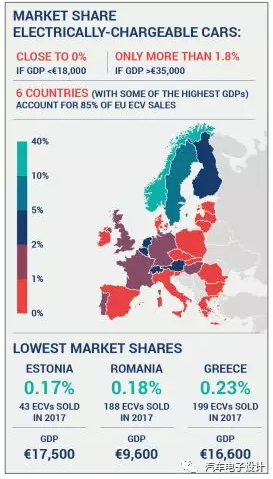First, the market acceptability of pure electric vehicles
In countries with per capita GDP below 18,000, the market share of the new energy vehicle market is almost 0%;
Half of the 28 EU member states have a market share of 0.75% or less in new energy vehicles;
In contrast, the new energy vehicle market share of more than 1.8% only occurs in countries with a per capita GDP of more than 35,000 euros.
Because of this imbalance, if you want to achieve an average of 30% within the EU, you need more than 50% in these affluent Western Europe.
Of course, this is also a bit of a confusion for me. The purchase price of electric cars in Europe is the core element that limits their use. In places where China may be somewhat separated, mainly consumer upgrades and rapid economic development, we are not sensitive to the price of cars, especially after the loan.
In the case of Europe, the government does not provide incentives, that is, where there is a difference in GDP per capita, such as Spain, Italy and other countries and Sweden, such a large deviation of penetration.
Second, the charging facility
76% of the charging facilities are concentrated in 4 EU countries, nearly 30% in the Netherlands (32,875), 22%;
In Germany (25,241), France 14% (16,311) and the UK 12% (14,256);
To achieve higher average penetration rates, at least 2 million charging facilities will be needed by 2025, which will increase by a factor of twenty in less than seven years, and may continue to create greater distribution imbalances;
Countries with a vast territory like Romania have only 114 charging points, accounting for 0.1% of the EU total.
European charging facility Europe's charging facility

Third, no money
The government has no real support for charging infrastructure investment:
Only one-third of EU member states provide subsidies for charging infrastructure, and investments in such infrastructure require state-level support, as well as actual operator investment;
In the absence of subsidy funds, let consumers choose new energy vehicles, only by letting them see more charging facilities, so that ordinary consumers become charging parties, changing habits.
The implementation of the New Energy Vehicle Charging Infrastructure Outline (DAFI) in various countries is relatively weak. Without specific targets, many countries are actually not doing it very seriously.
At present, the government's level of CO2 emissions from vehicles is basically linked to car companies, but there is no connection between them and new energy vehicle charging facilities. In Europe, car companies do not have so much resources to cover charging piles, so many policies are not accepted by consumers. Degree hook.
1.Super LA series Swing-arm Robot is applicable to all types of horizontal injection machines for take-out products and sprues.
2.Single stage and telescopic type arms.
3.After installed robot, the productivity will be increased, and also reduce defective rate, ensure safty of operators, reduce manpower and accurately control the output to reduce waste.
LA Oblique Manipulator Series,Robot Arm For Injection Molding Machine
Ningbo Rainbow Plastics Machinery Co., Ltd. , https://www.injection-machine.com